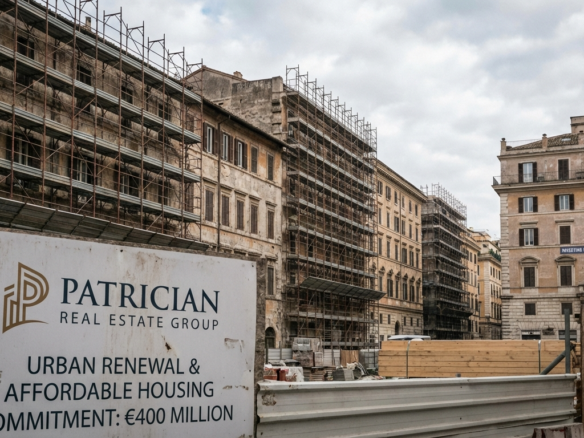Property taxes across Europe vary dramatically, creating significant differences in homeownership costs from country to country. Understanding these variations is crucial for anyone considering purchasing property abroad or comparing their current tax burden with neighboring nations. The landscape of European property taxation reveals fascinating patterns that reflect different governmental approaches to revenue collection and wealth distribution.
Get one year Free Listings!
Subscribe to our newsletter and get 1 year listings + XML imports for free and enjoy a 100% discount on all listing placement packages, no strings attached!

Recent data shows that property tax rates and collection methods differ substantially across the continent, with some countries relying heavily on real estate taxes while others barely touch this revenue source. These differences can impact everything from property investment decisions to retirement planning for Europeans looking to relocate within the EU.
Property Tax Burden: Europe’s Biggest Collectors
France leads Europe in total property tax collection, generating approximately €72 billion annually from real estate taxes. This massive figure represents the largest property tax haul on the continent, reflecting both France’s substantial property market and its comprehensive taxation system. The French system combines multiple property-related taxes, including the taxe foncière for property owners and various local surcharges that can significantly increase the overall burden.
Germany follows as the second-largest collector, though with a notably different approach to property taxation. German property taxes have historically been relatively low compared to other major European economies, but recent reforms are reshaping this landscape. The country’s federal structure means property tax rates can vary considerably between different states and municipalities, creating a complex patchwork of local taxation policies that property owners must navigate.
How Much Europeans Pay in Property Taxes
The average property tax burden varies enormously across European nations, with some countries imposing rates that would shock homeowners in lower-tax jurisdictions. In the United Kingdom, property owners face council tax bills that can reach several thousand pounds annually, particularly in high-value areas like London and the Southeast. These taxes fund local services and represent a significant ongoing cost of homeownership that buyers must factor into their purchasing decisions.
Nordic countries generally impose higher property tax rates, with Denmark and Norway requiring substantial annual payments from property owners. Danish property taxes can exceed 1% of property value annually, while Norwegian municipalities set their own rates within national guidelines. These higher rates often correlate with more comprehensive public services, creating a trade-off between tax burden and government-provided amenities that varies significantly across European borders.
Countries Where Homeowners Face Highest Rates
Belgium stands out as having some of Europe’s most complex and burdensome property tax systems, with multiple overlapping taxes that can create substantial costs for homeowners. The country imposes registration fees, annual property taxes, and various regional surcharges that combine to create one of the continent’s highest effective property tax rates. Belgian property buyers face immediate costs through registration duties that can reach 12.5% of purchase price in some regions, followed by ongoing annual obligations.
Italy presents another challenging environment for property owners, with municipal property taxes (IMU) that can be particularly steep for luxury properties and second homes. Italian tax rates vary by municipality and property type, with some coastal and tourist areas imposing premium rates that reflect local property values. The complexity of Italian property taxation often requires professional guidance, as rates and exemptions change frequently and vary significantly between different property categories and geographic regions.
Property Tax Share of Total Government Revenue
Property taxes represent vastly different portions of total government revenue across European countries, revealing distinct fiscal philosophies and economic structures. In France, property taxes account for approximately 8.7% of total tax revenue, making real estate a significant contributor to government coffers. This substantial reliance on property taxation reflects France’s mature property market and the government’s strategy of diversifying revenue sources beyond income and corporate taxes.
Several European nations collect surprisingly little revenue from property taxes relative to their overall tax intake. Countries like Austria and Germany have traditionally kept property tax rates low, with real estate contributing less than 2% of total tax revenue in some cases. This approach often means these countries rely more heavily on income taxes, VAT, and other revenue sources, creating different overall tax profiles that can significantly impact residents’ total tax burden depending on their income and spending patterns.
Regional Differences in European Tax Systems
Northern European countries typically embrace higher property tax rates as part of their comprehensive welfare state funding models. Sweden, Denmark, and Finland all impose substantial property-related taxes, viewing real estate as an appropriate target for taxation given its immobile nature and correlation with wealth. These countries often provide extensive public services in return, including healthcare, education, and infrastructure that property taxes help fund directly through local government budgets.
Southern and Eastern European nations generally maintain lower property tax rates, though this is changing as governments seek to diversify revenue sources and comply with EU fiscal guidelines. Spain and Portugal have both increased property tax rates in recent years, while countries like Poland and Czech Republic are gradually reforming their systems to generate more revenue from real estate. These changes reflect broader economic development patterns and the ongoing evolution of European tax policy as the continent adapts to changing demographic and economic pressures.
The variation in property tax rates across Europe creates a complex landscape for property owners and potential buyers to navigate. Understanding these differences is essential for making informed decisions about where to purchase property, as the ongoing tax burden can significantly impact the total cost of homeownership over time. Countries with higher property taxes often provide more comprehensive public services, while lower-tax jurisdictions may require property owners to budget for private alternatives.
As European governments continue to evolve their tax policies in response to economic pressures and demographic changes, property taxation will likely remain a key area of focus. Staying informed about these trends and understanding the tax implications in different countries can help property owners and investors make better decisions about their real estate portfolios across the continent.






Join The Discussion